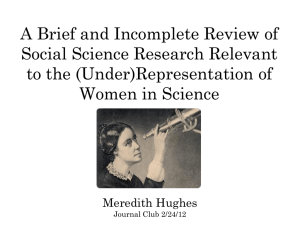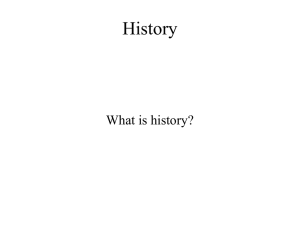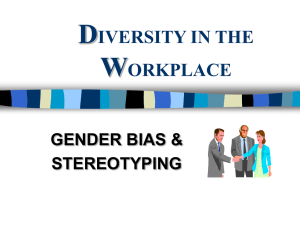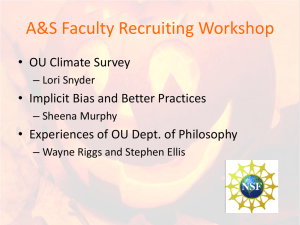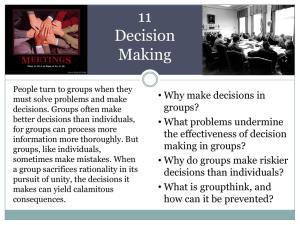Implicit bias, stereotype threat and leadership issues
advertisement
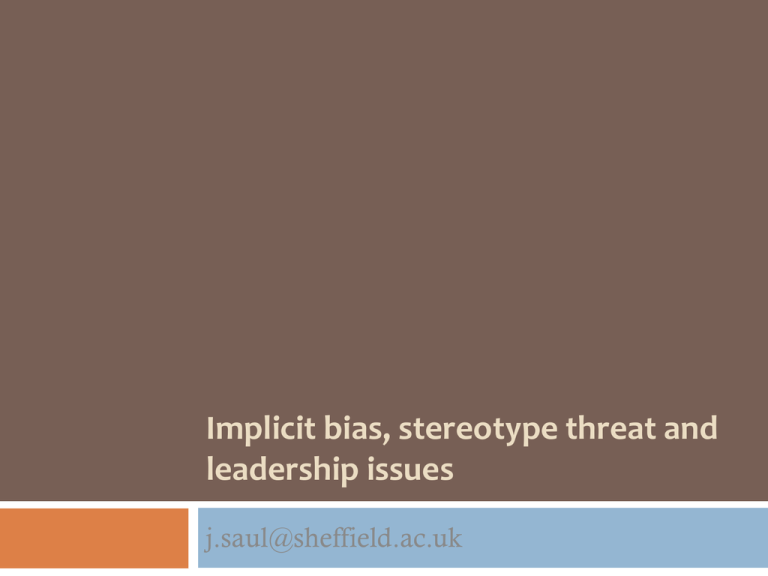
Implicit bias, stereotype threat and leadership issues j.saul@sheffield.ac.uk Gender gaps Low numbers of women in Science, Engineering, Mathematics. Also in certain Arts and Social sciences subjets. Low numbers of women at the top in almost every field Pay gaps (UK): Overall 18.6% less/hour. More women at the bottom: much higher rates of female poverty Explanations Innate, unchangeable psychological differences? Could be, but there are good reasons for doubt. (See esp. Cordelia Fine, Delusions of Gender) Difficulty combining work and childcare? Surely an issue, but can’t explain why there are so many more women in literature or law than in science or philosophy. Conscious, old-fashioned sexism? Still exists, but not so widespread. But there’s very good reason to believe that unconscious psychological phenomena are playing a role. These also play a key role in holding back members of other and overlapping stigmatised groups– racial and ethnic groups, disabled people, etc. Two phenomena Implicit Biases: those that we will be concerned with here are unconscious biases that affect the way we perceive, evaluate, or interact with people from the groups that our biases “target”. Stereotype Threat: people’s awareness of their group membership may (often unconsciously) have a negative impact on their performance. Implicit Bias Arises from our very useful tendency to make fast associations. Psychological research over the last decades has shown that most people-- even those who explicitly and sincerely avow egalitarian views-- hold what have been described as implicit biases against such groups as blacks, women, gay people, and so on. Example: Race IAT (US) Importantly… These are often contrary to genuinely held commitments. They are held even by members of the target group. Try an IAT Go to Project Implicit on the web, make sure you select right country. Bias in action: teaching More likely to call on male students, more likely to charitably interpret their inchoate contributions. More likely to take point raised by a woman seriously if re-stated by a man. © The University of Sheffield 13/04/2015 Bias in action: marking Non-anonymous marking and gender: anonymous marking leads to higher marks for women (Bradley 1984, 1993) Letters of Reference Man: “brilliant”; “outstanding”; “original” Woman: “works hard” “friendly” “surprisingly successful” “very attractive” “friends with my wife” © The University of Sheffield 13/04/2015 Women and leadership Women and leadership Bias in action: Hiring CVs: Same CV, with different names John more employable than Jane. John more employable than Yasser. Add indication of parenthood– helps men, Harms women Dying out? No: Shown 2012. Effect equally Strong for men and women, of all ages. Bias in action: citation 2013 study Of faculty members at research universities, the average paper by an untenured male in international relations is cited 26.7 times, while the average paper by a female colleague at same level would be cited only 2.15 times. Bias in action: shooter bias Subjects (including police) more likely to “shoot” black person carrying harmless object than white person. (Task is to “shoot” quickly if person in image is carrying a gun.) Implicit bias results in injustice Examples: People not receiving the marks that they should Hiring not based on merit Innocent people being shot BLAME? Unconscious, automatic, not subject to direct control, contrary to genuine egalitarian commitments. People often do not know what to do to prevent bias/bias effects, even if they are aware that they may have biases. So (I think) not subject to blame in the same way as conscious bias. STEREOTYPE THREAT Underperformance on particular tasks by members of groups stigmatised as less good at these tasks, when They really care about doing well Stakes are high They are reminded of their group membership Stereotype threat Women who are reminded of their gender (by ticking a gender box, or by being surrounded by men). taking a high-stakes math test, will underperform. Stereotype threat Black men taking tests “of academic ability” will underperform. Stereotype threat White men at Ivy League universities doing tests of athletic ability will underperform if reminded of their race. Stereotype threat 5-7 year old girls will do worse on a math test if they take it after colouring in a picture of a girl with a doll. Stereotype threat in action With exactly the same talent and dedication, it will be harder for members of some social groups to perform well: UNJUST. Many people will fail to perform as well as they otherwise might. Society will not have the benefit of the full contributions that some groups might make. Implicit bias and stereotype threat in action Members of stigmatised groups have a more difficult time being given proper credit for what they do and also a more difficult time doing as well as they can. Members of stigmatised groups will be less likely to be perform as well as they can, to be fairly assessed, to be encouraged, to be mentored, to be hired, to be paid fairly…. And– although there is in fact still conscious, explicit bias– much of this will be the result of unconscious bias from people with genuine egalitarian commitments. Our moral position We are, very likely, being influenced by biases that we find abhorrent. We are, very likely, acting in ways that: Are based in values we reject Have harmful effects on others (and perhaps on ourselves) Perpetuate racism, sexism and other injustices Are unfair Our epistemic position (what this means for knowledge) Before learning about implicit biases, we don’t know that we are likely to be doing these things. Even once we learn about implicit biases, we don’t know when they are influencing what we do. Our epistemic position These biases can affect us even when we are thinking about things on which we are experts: Prestige bias: Papers already published in top journals sent to them again, but with unprestigious (little-known) university affiliations for the authors. Rejected. For serious methodological errors. Our epistemic position When psychologists make mistakes like this, they’re making mistakes about something they know well– methodology. These mistaken evaluations are being influenced by totally irrelevant factors. They’re being influenced by factors that the psychologists would find repugnant. This is all happening totally outside their awareness. Our epistemic position Yes, but everyone makes mistakes! That’s part of our self-conception. Mistakes like there are not part of our selfconception. Traditional Philosophical Problem: Scepticism Sceptical arguments, traditionally, get us to think about some possibility that we can’t rule out. Then they get us to move from that to the thought that we really don’t know (for example) that anything around us is real. Traditional scepticism Doesn’t really worry anyone. We don’t really have a reason to take the sceptical doubts seriously. Implicit Bias Scepticism Learning about implicit bias tells us that we almost certainly are making mistakes. So stronger than traditional forms. Not mistaken about everything. But a lot, and stuff that we were pretty confident of. Implicit Bias Scepticism But traditional scepticism is quite sweeping. Doubt induced by implicit bias less so– e.g. could not make us worry about whether the external world exists. It’s local scepticism, not global. But it’s local scepticism where the boundaries are uncertain– there are so many areas in which social identity could be affecting us, and so many of our beliefs might have been affected. Demand for action Traditional scepticism: not really. Implicit bias scepticism: strong demand. Acting: What not to do Don’t just tell yourself “don’t be biased”. This can backfire and make it worse. Don’t think about a past time when you (think that you) managed to be unbiased. This can backfire and make it worse. Don’t tell yourself not to see gender and race. (Again, backfires.) Acting: what only sort of works Putting women on hiring committees in order ensure gender fairness. Women, like men, are very likely to hold negative implicit biases against women. So won’t help with implicit bias. However: can help candidates not to suffer from such serious stereotype threat while being interviewed. But note: One woman probably won’t be enough. Acting: what works for implicit bias Anonymise whenever possible. What works Spend some time thinking about counterstereotypical exemplar…. Acting: what works Get more counterstereotypical exemplars in. In my own field, philosophy (75-80% male) I argue not just for hiring more women, but also putting women on reading lists, inviting them to speak, etc. Put their pictures up. Objection to adding counterstereotypical exemplars But that means basing one’s judgments (in part) on something other than merit! Our judgments are already (in part) based on something other than merit: they are based partly on social prejudices. What works Being hungry, tired and rushed increases manifestation of implicit bias. What works Agree on criteria in advance. Don’t put too much weight on one thing (e.g. job talk). Get feedback on each element as you go, to avoid overall gestalt evaluation. Acting: what works for implicit bias Spend some time thinking about past instances where you were biased. What works Try harder to notice when a woman student wants to speak. If a woman’s comment is being ignored, or attributed to someone else, speak up. Perhaps: adopt an affirmative action policy in chairing discussions. Re-examine your letters of reference for gendered content. Cite women. Acting: what works for stereotype threat Think about a group one is a member of which is not negatively stereotyped. (E.g. people at Russell Group university.) What works Stereotype threat: sharing stories of those who have succeeded despite it. Stereotype threat: talk about it as a possible source of anxiety. Stereotype threat: values affirmation. Notice… Many of these ways of countering our biases really require scientists to discover them. What we’d most naturally think of to do doesn’t work, and some strange things do. To fix our cognitive instruments we first have to accept that they are faulty, and that we need some expert help. Standard picture of bias Standard picture of bias is one on which the biased people are very obviously and consciously racist and sexist. Easy to distance oneself from these people, and reflect in relief on one’s lack of bias. Need to reject this, and accept ubiquity. But Importantly: this doesn’t mean we’re terrible, racist people. Bias as blameless This is the picture we must reject: many biases are both unconscious and blameless. Many people are totally unaware of their implicit biases and the effects that they have. Even after becoming aware, people are likely to not know how to combat them. So blame is not appropriate Bias as blameworthy Bias becomes blameworthy if people learn about implicit bias and don’t try to do anything to change.
